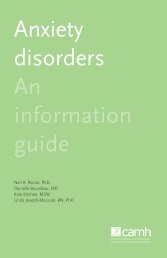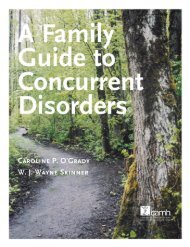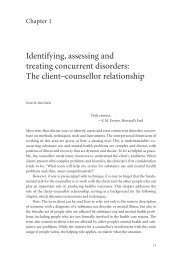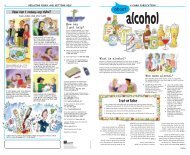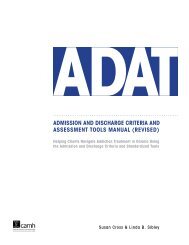Cognitive-behavioural therapy: An information guide - CAMH ...
Cognitive-behavioural therapy: An information guide - CAMH ...
Cognitive-behavioural therapy: An information guide - CAMH ...
You also want an ePaper? Increase the reach of your titles
YUMPU automatically turns print PDFs into web optimized ePapers that Google loves.
CBT approaches to <strong>behavioural</strong> change<br />
31<br />
with beetles rates situations involving beetles—from mildly distressing<br />
to most distressing.<br />
Table 5. Hierarchy of feared situations: Example<br />
FEARED SITUATION<br />
(mildly distressing to most distressing)<br />
DISTRESS<br />
(10–100)<br />
View cartoon drawing of beetles, then touch it 10<br />
View photo of real beetles, then touch it 20<br />
Stand in room with small beetles, walk within five feet 30<br />
of beetles<br />
Walk within one foot of small beetles 40<br />
Stand in room with large beetles, walk within five feet 50<br />
of beetles<br />
Walk within one foot of large beetles 60<br />
Touch small beetles with finger 70<br />
Allow small beetles to crawl on arm 80<br />
Touch large beetles with finger 90<br />
Allow large beetles to crawl on arm 100<br />
At first you will complete exposure tasks with the help of the<br />
therapist. Later, as you progress, you will be asked to do them on<br />
your own as homework between sessions. The rate at which you<br />
progress in treatment will depend on the severity of your fear and<br />
on your ability to tolerate the discomfort associated with arousing<br />
your anxiety. Exposure tasks need to be repeated and last long<br />
enough (usually not less than 30 minutes) to result in optimal<br />
improvements. You learn that anxiety comes down naturally when<br />
you remain in the fear-provoking situation long enough.



